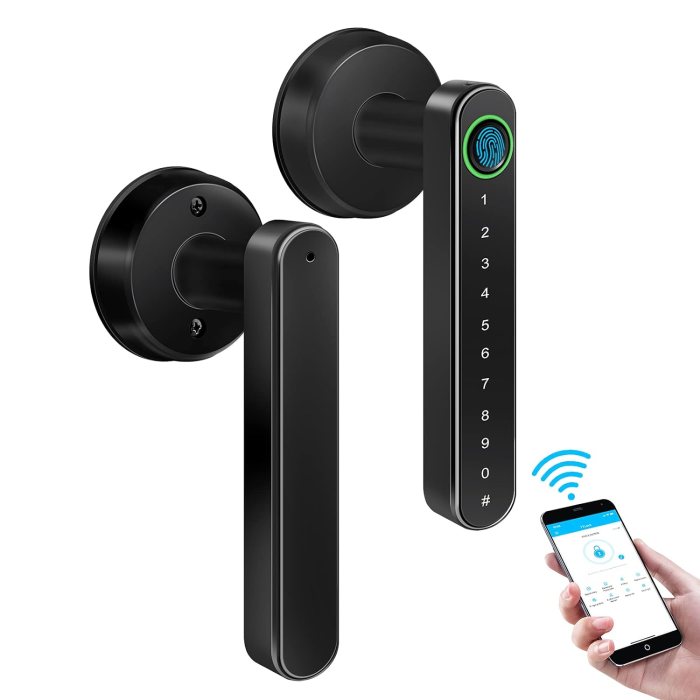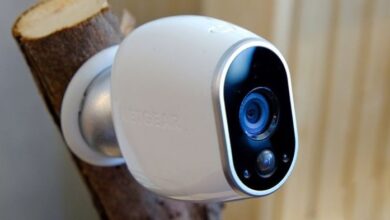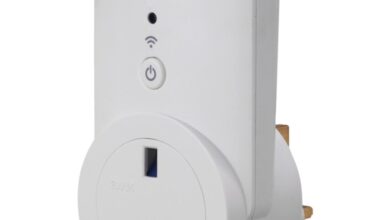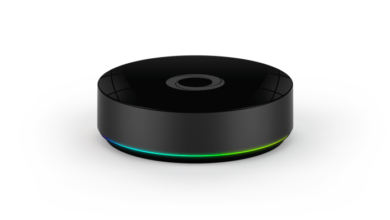Smart Door Locks A Comprehensive Guide
Smart Door Locks: Step into a world where convenience meets cutting-edge security. Forget fumbling with keys; imagine unlocking your door with a fingerprint, a smartphone app, or even your voice. This isn’t science fiction; it’s the reality of smart locks, a rapidly evolving technology transforming home security. We’ll delve into the intricacies of various smart lock types, explore their vulnerabilities and robust security measures, and navigate the exciting landscape of smart home integration.
Get ready to unlock a new level of home security and convenience.
From the simple elegance of keypad locks to the futuristic appeal of biometric authentication, smart locks offer a diverse range of options to suit every lifestyle and security need. This guide will unpack the mechanics behind these innovative devices, comparing their strengths and weaknesses, and providing insights into their seamless integration within the broader smart home ecosystem. We’ll also examine the latest market trends and future advancements, ensuring you’re equipped with the knowledge to make an informed decision about securing your home with the latest technology.
Smart Door Lock Types and Mechanisms
Smart door locks represent a significant leap forward in home security and convenience, offering a range of options to suit diverse needs and budgets. Understanding the different types and their underlying mechanisms is crucial for making an informed decision, ensuring both security and ease of use. This exploration delves into the specifics of various smart lock technologies, comparing their strengths and weaknesses to help you choose the best fit for your home.
Smart Lock Types
Smart door locks are available in a variety of forms, each utilizing different technologies for authentication and access control. The choice depends on individual preferences regarding convenience, security, and budget. Key factors influencing the decision often include the level of technological sophistication desired and the overall aesthetic integration with the existing home design.
Keypad Smart Locks
Keypad locks use a numerical keypad for entry, requiring users to input a specific code. The internal mechanism typically involves a motorized bolt that engages and disengages based on the correct code entry. Security depends on the robustness of the keypad’s design, its resistance to tampering, and the complexity of the access code. Simpler keypads might be vulnerable to brute-force attacks, while more advanced models offer features like auto-locking and tamper alerts.
These locks are generally straightforward to install and use, making them a popular choice.
Fingerprint Smart Locks
These locks employ biometric technology, using a fingerprint scanner to verify identity. The internal mechanism involves a sensor that captures a fingerprint image and compares it against stored templates. If there’s a match, the lock unlocks. Fingerprint scanners offer a high level of security, as fingerprints are unique and difficult to replicate. However, the accuracy and reliability of the scanner can vary depending on the quality of the sensor and environmental factors such as moisture.
Higher-end models often feature advanced algorithms to mitigate false positives and negatives.
Smartphone-Controlled Smart Locks
These locks utilize Bluetooth or Wi-Fi connectivity to communicate with a smartphone app. The unlocking process involves using the app to send a signal to the lock, triggering the unlocking mechanism. The internal mechanisms are typically motorized, similar to keypad locks, but controlled remotely. Security relies on the security of the app, the encryption protocols used, and the strength of the user’s smartphone password.
This type offers the highest level of convenience, allowing for remote access and key sharing. However, it requires a reliable internet connection and is vulnerable to hacking if security protocols are weak.
Key Fob Smart Locks
Key fob locks utilize a small, handheld remote control device to unlock the door. The fob transmits a radio signal to the lock, activating the unlocking mechanism. The internal mechanism is usually a motorized bolt or similar system. Security relies on the strength of the radio frequency encryption and the difficulty of cloning the key fob. These locks offer a balance between convenience and security, being simpler to use than smartphone-controlled locks but less vulnerable to hacking than keypad locks.
Smart Lock Comparison
| Lock Type | Features | Price Range | Security Level |
|---|---|---|---|
| Keypad | Numeric code entry, auto-lock | $50 – $200 | Medium |
| Fingerprint | Biometric authentication, tamper alerts | $100 – $300 | High |
| Smartphone-Controlled | Remote access, key sharing, notifications | $150 – $400 | Medium-High (dependent on app security) |
| Key Fob | Remote unlocking, simple operation | $75 – $250 | Medium |
Smart Lock Security and Vulnerability
The convenience of smart locks is undeniable, but their increasing integration into our homes raises crucial questions about security. These devices, while offering a modern upgrade to traditional locking systems, are not immune to vulnerabilities, both physical and digital. Understanding these weaknesses and the security measures in place is paramount to ensuring the safety and security of our homes and personal belongings.
This exploration will delve into the potential threats and the technological safeguards designed to mitigate them.Smart locks, while offering convenience, introduce new avenues for potential attacks. These vulnerabilities can be broadly categorized into physical tampering and digital hacking. Physical attacks involve brute-force methods, lock picking, or even destructive entry. Digital attacks leverage vulnerabilities in the lock’s software or communication protocols to gain unauthorized access.
The effectiveness of security protocols hinges on their robustness and the user’s diligence in maintaining security best practices.
Physical Tampering Vulnerabilities
Physical attacks represent a significant threat to smart lock security. A determined attacker might attempt to bypass the lock’s mechanism entirely, using tools to force the door open, disable the locking mechanism, or even remove the lock from the door. Another potential vulnerability lies in the lock’s physical construction. A poorly designed or manufactured lock may be more susceptible to physical attacks, such as picking or drilling.
The materials used in the lock’s construction also play a crucial role in its resilience against physical tampering. High-quality, hardened materials are essential for resisting forceful attacks.
Digital Hacking Vulnerabilities
Digital attacks exploit weaknesses in the smart lock’s software and communication protocols. These attacks can range from exploiting software bugs and vulnerabilities to intercepting communication signals between the lock and its controlling device. A common vulnerability involves weak or easily guessable passwords or default settings left unchanged by the user. Moreover, the use of insecure communication protocols, such as unencrypted Wi-Fi, can expose the lock to eavesdropping and manipulation.
Man-in-the-middle attacks, where an attacker intercepts communication between the user and the lock, are a significant concern. This type of attack allows the attacker to gain unauthorized access by intercepting and manipulating the communication signals.
Security Protocols in Smart Locks
Manufacturers employ various security protocols to mitigate these risks. Encryption, a crucial component of smart lock security, protects data transmitted between the lock and its controlling device. Strong encryption algorithms make it extremely difficult for attackers to decipher the transmitted information, even if intercepted. Multi-factor authentication adds another layer of security, requiring users to provide multiple forms of verification, such as a password, fingerprint, or a code from a mobile app.
This makes it significantly harder for attackers to gain unauthorized access, even if they manage to compromise one security layer. Regular software updates address vulnerabilities and improve the overall security of the system. Keeping the smart lock’s software updated is crucial for maintaining its security posture.
Real-World Security Breaches
Several real-world incidents highlight the vulnerabilities of smart locks. In one notable case, a vulnerability in a popular smart lock’s software allowed attackers to remotely unlock the lock using a simple exploit. The vulnerability stemmed from a flaw in the lock’s authentication process, allowing attackers to bypass security measures. The cause was traced to inadequate software testing and a lack of robust security protocols during the development process.
Another instance involved physical tampering, where an attacker used a specialized tool to bypass the lock’s physical mechanism. The vulnerability was attributed to the lock’s relatively weak physical construction and the lack of sufficient tamper-resistant features.
Hypothetical Scenario: Successful Attack
Imagine a scenario where an attacker gains access to a smart lock’s Wi-Fi network. Using specialized software, they intercept the communication between the user’s smartphone and the smart lock. They exploit a known vulnerability in the lock’s software, allowing them to bypass the authentication process and unlock the door remotely. The attacker could then gain physical access to the property.
Hypothetical Scenario: Unsuccessful Attack
In contrast, consider a scenario where a similar attack is attempted on a smart lock equipped with robust security measures. The lock uses strong encryption, multi-factor authentication, and regularly receives software updates. The attacker’s attempts to intercept the communication are unsuccessful due to the strong encryption. Even if the attacker manages to guess the user’s password, the multi-factor authentication requires additional verification, preventing unauthorized access.
The attacker’s attempt is ultimately unsuccessful.
Smart Lock Integration and Compatibility: Smart Door Locks

The seamless integration of your smart lock into your existing smart home ecosystem is crucial for maximizing its functionality and convenience. A well-integrated smart lock allows for centralized control, automation, and enhanced security features, transforming your home into a truly connected space. Understanding the various integration methods and compatibility factors is key to making an informed purchasing decision.Smart locks utilize a variety of communication protocols to connect with other devices and platforms.
This choice significantly impacts their integration capabilities and overall compatibility.
Communication Protocols Used by Smart Locks
Smart locks employ different communication protocols, each offering unique advantages and disadvantages. Wi-Fi offers long-range connectivity and is ideal for remote access and control. Bluetooth provides a more energy-efficient connection, typically used for local control and pairing. Z-Wave, a mesh networking protocol, boasts enhanced range and reliability, often found in more robust smart home systems. The selection of the protocol directly impacts the range of compatible smart home systems and the features available.
For instance, a Wi-Fi-enabled smart lock can be controlled from anywhere with an internet connection, while a Bluetooth lock requires proximity to the device.
Smart Lock Compatibility with Operating Systems and Smart Home Ecosystems
Compatibility across different operating systems (iOS, Android) and smart home ecosystems (Apple HomeKit, Google Home, Amazon Alexa, Samsung SmartThings) is a critical consideration. Not all smart locks are created equal in terms of their breadth of compatibility. Some locks may only work with specific platforms, limiting their usability for users with diverse smart home setups. For example, a lock compatible only with Apple HomeKit will not integrate with a Google Home system.
Choosing a lock with broad compatibility ensures wider integration options and future-proofing your smart home investment.
Popular Smart Home Platforms and Smart Lock Compatibility
The choice of smart lock should align with your existing or planned smart home platform. Consider these popular platforms and their compatibility with leading smart lock brands:
- Amazon Alexa: Compatible with a wide range of smart locks from brands like August, Schlage, and Kwikset, offering voice control and integration with other Alexa-enabled devices. For example, you can unlock your door simply by saying, “Alexa, unlock the front door.”
- Google Home: Integrates with smart locks from Yale, August, and others, allowing for voice control and automation within the Google Home ecosystem. This allows for seamless integration with other Google-powered devices and services.
- Apple HomeKit: Offers compatibility with smart locks from August, Schlage, and other brands, providing secure and encrypted communication within the Apple HomeKit ecosystem. This ensures a high level of security for your smart lock and other HomeKit devices.
- Samsung SmartThings: Supports a variety of smart locks, including those from Kwikset and Yale, enabling centralized control and automation through the SmartThings platform. This platform often offers advanced features like geofencing and scheduling.
Choosing a smart lock that seamlessly integrates with your preferred smart home platform is essential for a cohesive and user-friendly smart home experience. Careful consideration of the communication protocols and operating system compatibility will ensure a smooth and efficient setup and operation.
Smart Lock User Experience and Features
The user experience with a smart lock hinges on several factors, primarily the type of lock, its features, and the ease of installation. A seamless and intuitive experience translates to increased user satisfaction and adoption, while a cumbersome or unreliable system can lead to frustration and ultimately, abandonment. Understanding the nuances of different smart lock designs and their functionalities is crucial for both consumers and manufacturers.Smart lock technology has significantly enhanced home security and convenience, offering a range of features that go beyond traditional key-based systems.
The user experience, however, varies considerably depending on the specific model and its functionalities. This section will delve into the typical user experiences associated with different smart lock types, highlight advanced features, compare installation and usage ease, and present a realistic user scenario.
Smart Lock User Experiences by Type
The user experience differs depending on the smart lock type. Keypad locks, for instance, offer a straightforward experience, requiring users to input a numerical code. This is generally quick and easy, but susceptible to code guessing or physical damage. Biometric locks, using fingerprint or facial recognition, provide a more secure and convenient experience, eliminating the need for codes or keys.
However, they might be more expensive and require accurate biometric data capture. Smart locks integrated with smartphone apps offer remote access and management capabilities, but rely on a consistent internet connection and can be more complex to set up initially. Each type presents its own trade-offs between security, convenience, and complexity.
Advanced Smart Lock Features
Many modern smart locks boast advanced features designed to enhance convenience and security. Auto-locking, a popular feature, automatically secures the door after a set period, eliminating the need to manually lock it. Keyless entry allows access via smartphone app, fingerprint, or keypad, eliminating the need to carry physical keys. Remote access enables users to unlock or lock their doors from anywhere with an internet connection, ideal for granting temporary access to guests or managing security remotely.
Guest codes provide temporary access codes for visitors, eliminating the need to share physical keys. These features contribute to a smoother and more secure user experience.
Smart Lock Installation and Use
Installation and use vary significantly depending on the smart lock model. Some models are designed for DIY installation, with clear instructions and simple tools required. Others might necessitate professional installation, especially if replacing an existing deadbolt mechanism or integrating with complex home automation systems. Similarly, user-friendliness differs. Simple keypad locks require minimal learning, while app-based smart locks require downloading and understanding the associated software.
Factors like the quality of the app’s interface and the clarity of instructions contribute greatly to the overall user experience.
A Day with a Smart Door Lock: A User Story
Imagine Sarah, a busy professional. She uses a smart lock with a fingerprint scanner and smartphone app integration. In the morning, she unlocks her door with her fingerprint, a quick and seamless process. During the day, she grants temporary access to a house cleaner via a temporary guest code sent through the app. In the evening, she locks her door remotely using her phone while traveling.
However, she once experienced a minor frustration when the internet connection was unstable, preventing her from remotely unlocking the door. This highlights both the convenience and the potential reliance on technology inherent in smart lock usage. Despite this occasional hiccup, Sarah finds the overall experience significantly more convenient and secure than traditional key-based systems.
Smart Lock Market Trends and Future Developments
The smart lock market is experiencing explosive growth, driven by increasing consumer demand for enhanced security, convenience, and integration with smart home ecosystems. This surge is fueled by technological advancements, shifting consumer preferences, and the rising adoption of IoT devices within residential and commercial spaces. Understanding current trends and anticipating future developments is crucial for both consumers and industry players navigating this rapidly evolving landscape.The current smart lock market is characterized by a significant shift towards biometric authentication.
Fingerprint scanners, facial recognition, and even voice recognition are becoming increasingly common, offering a more seamless and secure alternative to traditional keypads and physical keys. Simultaneously, there’s a noticeable focus on improved security features, such as advanced encryption protocols and tamper detection systems, addressing concerns about vulnerabilities and potential breaches. This heightened emphasis on security is a direct response to the increasing sophistication of cyber threats and the growing awareness of potential risks associated with connected devices.
Biometric Authentication and Enhanced Security Features
Biometric authentication is rapidly becoming the standard for smart locks, offering a more secure and user-friendly experience compared to traditional methods. Fingerprint scanners, for instance, provide a high level of security while eliminating the need to remember or manage physical keys. Facial recognition systems, while still relatively less common in smart locks, offer an even more convenient and hands-free experience.
Furthermore, the incorporation of advanced encryption protocols, such as AES-256, ensures that communication between the lock and the user’s device remains secure and resistant to unauthorized access. This robust security is complemented by tamper detection mechanisms that alert users to any attempts to compromise the lock. For example, a sudden surge of power drain might indicate tampering, triggering an immediate alert to the user’s smartphone.
This proactive approach is key to maintaining the integrity and trustworthiness of smart lock systems.
Future Developments in Smart Lock Technology
Future smart lock technology will likely see increased integration with advanced artificial intelligence (AI) and machine learning (ML). AI could enhance security by analyzing user behavior patterns and identifying anomalies that might indicate unauthorized access attempts. For example, AI could detect unusual access times or locations and alert the user accordingly. ML algorithms could also optimize the energy efficiency of smart locks, extending battery life and reducing power consumption.
Investigate the pros of accepting Voice-Controlled Home in your business strategies.
Imagine a smart lock that learns the user’s typical unlocking patterns and adjusts its power usage accordingly. Furthermore, we can anticipate improved interoperability between different smart home devices and ecosystems, enabling seamless integration with other smart home technologies such as lighting, security systems, and voice assistants. This level of integration will create a more cohesive and intelligent home environment.
Key Players and Market Share
Several key players dominate the smart lock market, each contributing significantly to innovation and market share. Companies like August Home, Schlage, Kwikset, and Yale are major players, offering a diverse range of smart locks catering to different needs and budgets. While precise market share figures fluctuate, these companies consistently hold significant portions of the market, fueled by their strong brand recognition, established distribution networks, and continuous product innovation.
The market also includes numerous smaller players specializing in niche segments or offering unique technological solutions, further contributing to the dynamism and diversity of the smart lock landscape. Competition among these players is driving innovation, leading to more advanced and affordable smart locks.
Impact of Advancements in Related Technologies, Smart Door Locks
Advancements in biometric sensors, secure communication protocols, and low-power electronics are significantly impacting the future of smart locks. The development of more accurate and reliable biometric sensors, for example, is leading to enhanced security and user experience. Similarly, improvements in secure communication protocols, such as Bluetooth Low Energy (BLE) and Zigbee, are enhancing the security and energy efficiency of smart locks.
The ongoing development of low-power electronics is also crucial, extending battery life and reducing the need for frequent replacements. For instance, the use of energy-harvesting technologies could potentially eliminate the need for batteries altogether, creating truly self-sufficient smart locks. These technological advancements work synergistically, driving the market towards increasingly secure, convenient, and energy-efficient smart lock solutions.
Smart Lock Installation and Maintenance
Installing a smart lock might seem daunting, but with the right approach and tools, it’s a manageable DIY project. This section details the typical installation process, troubleshooting common issues, and essential maintenance tips to ensure your smart lock remains secure and functional for years to come. Proper installation is crucial not only for convenience but also for maintaining the security features of the lock.
Neglecting maintenance can compromise the system’s integrity and leave your home vulnerable.
Smart Lock Installation Process
Successful smart lock installation hinges on careful preparation and precise execution. Begin by gathering the necessary tools and carefully following the manufacturer’s instructions. Improper installation can lead to malfunctions and security breaches, so precision is key. Remember to always prioritize safety during the process.
- Preparation: Gather your tools: a screwdriver (Phillips and flathead), a drill (with appropriate drill bits), a level, measuring tape, and potentially wire strippers and connectors, depending on your smart lock type. Carefully examine your existing door and lock mechanism to ensure compatibility with your chosen smart lock. Take photos of your existing setup before dismantling anything, this acts as a helpful visual guide for reassembly.
- Removing the Old Lock: Carefully remove your old door lockset, taking note of the order of removal and any peculiarities in its construction. This step often involves unscrewing the faceplate, removing the latch bolt, and disconnecting any existing wiring. A clear understanding of the existing mechanism is essential for seamless integration of the new smart lock.
- Installing the New Lock: Position the new smart lock mechanism onto the door, ensuring that it’s level and correctly aligned with the door frame. Use the provided template or markings to guide drilling for any new mounting holes. Secure the lock mechanism using the provided screws. This step requires accuracy to ensure proper function and security.
- Wiring and Connections: Carefully connect any necessary wiring according to the manufacturer’s instructions. This may involve connecting power, linking to an existing doorbell system, or integrating with a home automation system. Pay close attention to the color-coding and ensure all connections are secure. Incorrect wiring can cause malfunctions and even safety hazards.
- Testing and Calibration: Once the lock is installed, thoroughly test all functions. This includes locking and unlocking the door using both the physical key and the smart lock’s app or keypad. Calibrate the lock if necessary, following the manufacturer’s guidelines. A comprehensive test ensures proper functionality and identifies any potential issues early on.
Troubleshooting Common Smart Lock Problems
Even with careful installation, some issues may arise. Understanding common problems and their solutions can save time and frustration. Remember, always consult your smart lock’s manual for specific troubleshooting steps.
- Lock Won’t Unlock: Check battery levels, ensure proper network connectivity (for Wi-Fi locks), and verify that the lock is correctly aligned with the door frame. A weak signal or low battery is a frequent cause of malfunctions.
- Inconsistent Locking/Unlocking: This could indicate a problem with the motor or internal mechanism. Inspect the internal components for obstructions or damage. If the issue persists, contact customer support or consider professional assistance.
- Connectivity Issues: For smart locks that rely on Wi-Fi or Bluetooth, ensure a strong and stable signal. Restart your router and check for any network interference. Weak signal strength is a common cause of connectivity problems.
Smart Lock Maintenance and Security Tips
Regular maintenance extends the lifespan and security of your smart lock. This involves both physical cleaning and software updates. Proactive maintenance minimizes the risk of malfunctions and security vulnerabilities.
Clean the lock regularly using a soft, damp cloth to remove dust and debris. Avoid using harsh chemicals or abrasive cleaners. Regularly check the battery levels and replace them as needed. Keep the keypad or touchscreen clean to prevent malfunctions. Update the smart lock’s firmware regularly to benefit from bug fixes and security patches.
Regular updates address potential vulnerabilities and improve performance.
Conclusion
Smart door locks represent a significant leap forward in home security and convenience, offering a blend of cutting-edge technology and user-friendly design. While potential vulnerabilities exist, the robust security protocols and ongoing advancements in this field continue to mitigate these risks. By understanding the different types, security features, and integration capabilities, you can choose a smart lock that perfectly aligns with your needs and enhances your home’s safety and peace of mind.
The future of home security is smart, and it’s here to stay.









